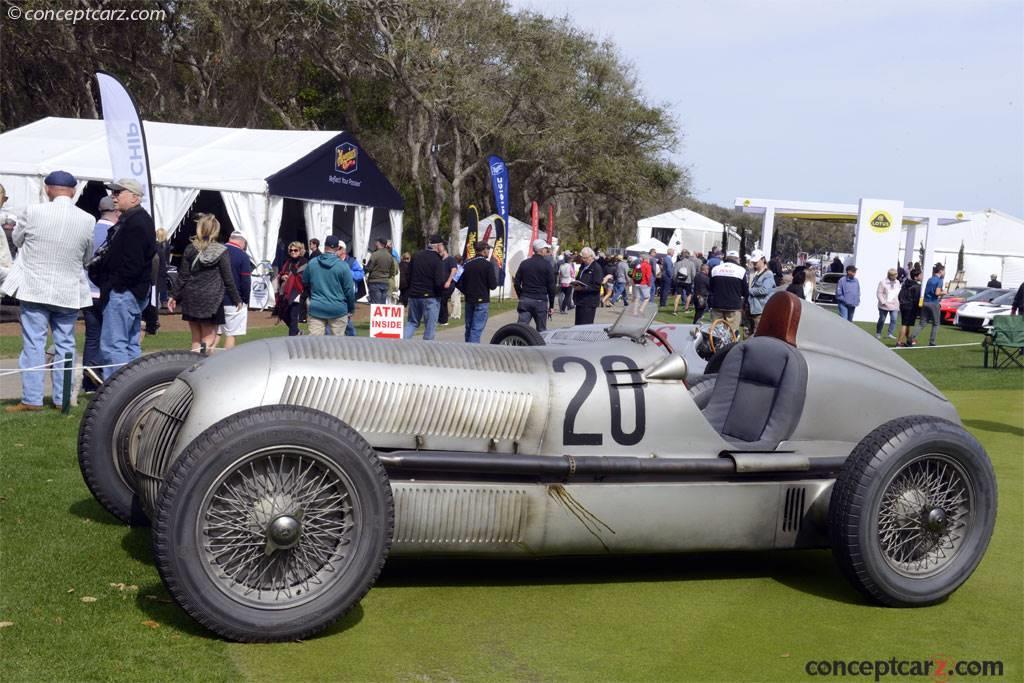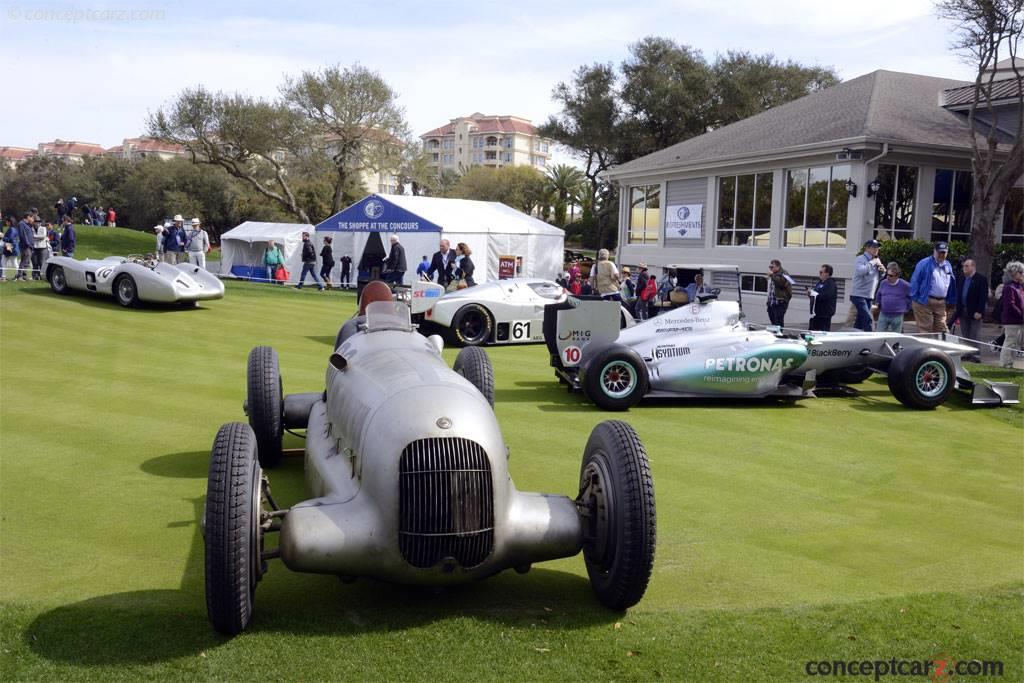On January 30th of 1933, the Government of Nazi Germany was appointed successor to the government of the Weimar Republic and inherited the government structure and institutions of the previous state. It also brought revised rules for the 1934 Grand Prix season. Fueled by the defeat of the Avus in May of 1933 to the French and Italians, abundant money was made available to the newly merged Daimler and Benz team. They were joined by the newly formed Auto Union group which fielded a Ferdinand Porsche design racecar. 1934 racing regulations dictated a maximum dry-weight of 750 kg, which made the previous seven-liter Mercedes-Benz SSk obsolete. Work began in March of 1933 and the new W25 was successfully debuted at the Nurburgring on June 3rd, 1934. It had raced at the 1934 Avusrennen race but withdrew due to carburetion problems. After the V16-powered Auto Unions also retired early, the race was won by an Alfa Romeo. At the Nurburgring, the W25 was slightly over the 750 kg minimum weight requirement. The team worked overnight to reduce weight where possible, including removing the white paint. On race day, the car appeared in bare-aluminum. The car driven by Manfred Von Brauchitsch, nicknamed the 'Silber Pfeil' by the radio commentators, finished first and began the legacy of the 'Silver Arrow.' For its time, the W25 was aerodynamic, and its 32-valve, supercharged inline eight-cylinder engine with dual overhead camshafts was a highly advanced power plant in its day. The engine was built from two groups of four separate forged-steel cylinders, and the valve-ports sheet-steel water-jackets were welded to the individual cylinder. A single Roots-type supercharger provided additional air to the unusual-style Mercedes-Benz carburetors. The engine displaced nearly 3.4-liters and offered approximately 354 horsepower. Keeping dry weight to a minimum of 750 kg was difficult as the engine weighed just over 200 kg, and much of the smaller pieces and mechanical components were cross-drilled to keep the W25 under the maximum limit. The conventional chassis was comprised of two longitudinal box-section beams, with a box-section frame strengthened by front cross-members and a cross-tube. As was typical for the era, holes were drilled into the frame to reduce the overall weight. Just like the chassis, the all-independent suspension was conventional with double wishbones in the front and a swing-axle rear setup. Coil springs actuated by bell-cranks were placed in the front and the lower wishbones were attached to friction dampers. Braking was provided by Lockheed hydraulic drums, a four-speed gearbox was combined with the final drive, and the body was formed from alloy. When reliability issues did not sideline the cars, the Mercedes-Benz and Auto Unions were the fastest during the 1934 season. The W25 won victories at two Italian and Spanish Grands Prix's, the Coppa Acerbo, and the Klaussenpass Hillclimb. Further development to the M25 engine brought about the M25AB engine, which had a slightly larger bore resulting in an increase in horsepower. The nearly 350 horsepower output rose to 370 horsepower by the close of the season. With many of the reliability issues resolved, and with the increase in power, the W25 enjoyed a dominant 1935 season, winning 9 major races, however losing the important German Grand Prix to an Alfa Romeo driven by Tazio Nuvolari. With its success, the W25 earned Mercedes-Benz the European Champions. For the 1936 season, the engine had been modified to the 'C' specification, which had a 4.3-liter displacement and over 400 horsepower. The team designed and experimented with a V12 engine but it was too heavy. So they refocused their efforts on the M25 engine, growing its displacement to 4.7-liters and its horsepower to over 450 bhp. Additional modifications were made to the aerodynamics of the car, giving it a new rear-end design, and the prior swing-axles were replaced by a DeDion axle, and the gearbox was mounted transversely. The W25K, with the 'K' representing short, was not as successful as the original W25. Its handling issues limited it to two Grand Prix victories during the season, giving the championship to the 6-liter Auto Union Type C driven by Bernd Rosemeyer.For the 1937 season, a larger engine was developed and installed in a new chassis. Given the name 'W125', it would return Mercedes-Benz back to the front of the pack.The W25 had begun the 'Silver Arrow' legend and had scored 16 victories in Grand Prix events as well as other major races for the Mercedes-Benz team.
by Daniel Vaughan | Mar 2020
by Daniel Vaughan | Mar 2020
Pre-WWII Grand Prix Racing VehiclesSimilarly Sized Vehicles
Similarly Sized Vehicles
from 1935
1935 Mercedes-Benz W25 Grand Prix Vehicle Profiles
Recent Vehicle Additions
Related Automotive News

ABARTH DAY: THE MOST INTERNATIONAL OFFICIAL ABARTH MEETING EVER
On Saturday 29th October, all Scorpion fans and their vehicles will meet on four European circuits Silverstone (UK), Nurburgring (Germany), Navarra (Spain) and Tazio Nuvolari (Italy).
Track driving, test drives, contests and parades will enhance a...

The Trident is Raised
One of Italys most famous marks, and perhaps most troubled, the trident-bearing automaker continues to provoke passion through its search of excellence.
Five brothers would come together in December of 1914 to found a motor company bearing their name—Maserati....

1964 Nurburgring 1000 Kilometers: Survive for One Last Victory
During the late 1950s, Richie Ginther would begin a relationship with John von Neumann and this partnership would result in one of the most dominant periods of American sportscar racing in which Ginther and Porsche would be virtually unbeatable. Nearly...

1956 24 Hours of Le Mans: The Rise of Two Counts
The 1955 24 Hours of Le Mans would end up being the darkest day in all of motorsport when Pierre Levegh launched off the back of Lance Macklins Austin-Healey and crashed into a barrier sending large portions of the car flying through the air acting...

1957 Italian Grand Prix: A True Nobleman Stands Amongst Two of F1's Most Noble
The sea of spectators overwhelming the circuit would be a truly awe-inspiring sight to behold. The vast majority of this horde was there to celebrate the car adorned in red finishing in the top three. The cars driver, a true royal, would stand amongst...

















